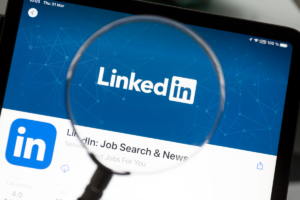How To Help Recruiters Alert You To Relevant Opportunities On LinkedIn
 It will come as no surprise that virtually every recruiter uses LinkedIn to find candidates. You’ve probably received at least a few unsolicited LinkedIn messages from recruiters. Chances are, some of these messages were in positions that didn’t align with your field of activity. This can be a source of frustration and cause some lawyers to become quite jaded about the general notion of recruiter outreach.
It will come as no surprise that virtually every recruiter uses LinkedIn to find candidates. You’ve probably received at least a few unsolicited LinkedIn messages from recruiters. Chances are, some of these messages were in positions that didn’t align with your field of activity. This can be a source of frustration and cause some lawyers to become quite jaded about the general notion of recruiter outreach.
But here’s the thing. When your LinkedIn profile doesn’t clearly communicate your skills and specific experience, recruiters are left to guess. The best way to improve the quality of recruiter outreach is to maintain an informative and up-to-date profile. This gives recruiters quick and valuable insight into your background so we can contact you if there is a strong match and vice versa if you are clearly not the right candidate. I can’t promise that a more informative profile will completely solve the issue of messages for irrelevant roles, but it will definitely help.
Present yourself effectively
The “intro” part of your LinkedIn profile (the top section) is the most important in many ways. This is your opportunity to clearly communicate who you are and what you offer. The best way to allow a recruiter to find your profile is to put descriptive keywords in the “headline” (the line just below your name). Simply calling yourself a “lawyer” is a missed opportunity: tell us what type of lawyer you are instead. The more specific, the better. For example, “Litigation Attorney” is better than “Attorney”. But a headline like “Employment Lawyer Specializing in Discrimination and Retaliation” is best.
Double check that your location is up to date. Many lawyers have relocated during the pandemic and some have failed to update their LinkedIn profiles accordingly. It only takes a moment! While you’re at it, it’s a good idea to select the “Open for Jobs” setting, which is only visible to recruiters. This will confidentially let recruiters know that you are receptive to relevant contacts.
Photos are another important element of an effective intro section. Adding a photo increases the likelihood that a potential contact will accept your connection request by 9 times. Besides uploading a professional profile photo, make sure to add a background photo. Your background is a visual representation of your personal brand and is one of the first things recruiters see when they visit your profile.
Enter the details
A basic rule: if it’s there, fill it out. The more complete your profile, the better. Of course, you need to fill in experience and education. Additionally, add some content related to skills (if recruiters filter by those keywords) and your licenses and certifications (you’re a member of a bar, right?). Other optional sections can help add a more personal touch to your profile. are you bilingual Fill out the Languages section!
Make sure your experience section is more informative than a simple list of titles. The beauty of LinkedIn, unlike a resume, is that you don’t have to worry about getting all the content onto a printed page. So go ahead and add a few bullet points to each of your previous positions to detail what you’ve done and what you’ve accomplished. Of course, this will change over time as you advance in your career and achieve new things, so don’t just fill out the experience section once and forget about it – be proactive by updating your current role description keep. For style reasons, note that it’s perfectly appropriate to write in the first person on LinkedIn, which would be unusual on a resume. Using “I” statements helps humanize you.
Education should be fairly easy, but remember this is not the place to be humble. If you graduated with honors, say so. You may also want to list your GPA and/or class rank, especially if you are early in your career and have limited work experience.
stay active
You should log in to LinkedIn at least weekly to check your messages. If you do not log in regularly, you can also include your contact information (personal email address and/or mobile phone number) in your profile so that recruiters can contact you through these alternative channels.
As an optional bonus, consider creating content on LinkedIn. This will improve your ranking in search results and can be a great way to get noticed – not just by recruiters but maybe even by law firm partners directly. Being active on the platform creates credibility and shows that you know your area of law and are happy to speak about it publicly. This is by no means required, but if you do it well, it definitely helps!
Check your search appearances
Make sure you are being noticed by the right audience. To do this, go to your profile page, look under the “Analytics” heading, look for the magnifying glass icon and click “Search gigs”. This allows you to see how often you appear in search results. In addition to the number of search occurrences, it also shows you the keywords for which you were found. If these don’t align with your current field of activity or industry, consider adjusting your headline and introduction section until you appear in more targeted searches.
Have fun
Have fun at last. Networking and being open to new opportunities can be intimidating, but LinkedIn makes it relatively easy and stress-free. Think of it as a no-pressure environment where you can be yourself and connect with like-minded people.